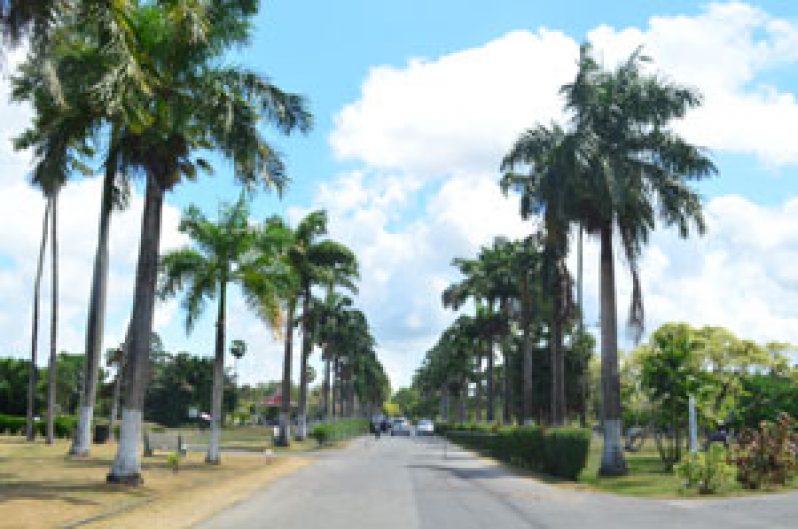THE Botanical Gardens, one of the popular recreational parks in Georgetown, is 135 years old this year.
 Former Curator at the Gardens, Mr. Fitz Ogle, disclosed that at a meeting of the Royal Agricultural and Commercial Society (RACS) held on April 03, 1877, members were convinced that great benefits were to be derived from establishment of the Botanical Gardens in the vicinity of the city, and appointed a committee comprising Messrs. J. Hampden King, Henry Watson, Henry Kirke, W.H. Campbell and R.W. Imlach to prepare a memorial to the Governor and Court of Policy in this respect.
Former Curator at the Gardens, Mr. Fitz Ogle, disclosed that at a meeting of the Royal Agricultural and Commercial Society (RACS) held on April 03, 1877, members were convinced that great benefits were to be derived from establishment of the Botanical Gardens in the vicinity of the city, and appointed a committee comprising Messrs. J. Hampden King, Henry Watson, Henry Kirke, W.H. Campbell and R.W. Imlach to prepare a memorial to the Governor and Court of Policy in this respect.
The petition was favourably received, and the Attorney General and Messrs. Robert Smith and William Russell were appointed to plan a scheme. The initial plans came to fruition when 276 acres of the backlands of Plantation Vlissengen were bought by the Government for $72,000, and 185 acres of that land was taken over for the Gardens.
In 1878, Mr. Prestoe, of the Trinidad Gardens, came to the then British Guiana to examine the site and, accordingly, prepare a plan. Mr. J S Waby arrived in 1879 from Trinidad to begin establishment of the Garden.
A great amount of work had to be done before the land could be planted, as it was mostly swampland and pasture. Trenches had to be dug, roads constructed, propagation sheds erected, and the land raised by taking soil from lakes on the land, while the front of the Gardens was tile-trained.
It had seemed like a truly insurmountable task to establish the Garden, but Mr. Waby continued resolutely doing his task, and eventually, preliminary work was accomplished in propagating plants in what was known as the Old Observatory on Brickdam.
Among the first seedlings raised by J S Waby were samaan trees, some of which were planted along the north side of the Gardens. Others now form the avenue on Vlissengen Road.
In 1880, Mr. George Samuel Jenman arrived as Botanist and Superintendent of the Botanical Gardens, and the project made great progress under the care and diligence of Messrs. Jenman and Waby.
Jenman’s sterling contribution to development of the Botanical Gardens earned him much honour and respect internationally. Today, a clock installed on the Botanical Garden’s Office (formerly the Curator’s Office) bears his name as testimony to his remarkable achievement in shaping the Botanical Gardens of Guyana.
After Jenman’s death in 1902, changes were made to the layout of the Botanical Gardens. Drainage was improved; the famous arched “kissing bridge”, depicting the Victorian era, was constructed; and a bandstand was erected in memory of Mr. J. Brummel, the then Sheriff of Demerara.
The Botanical Gardens were continuously beautified as flowering and ornamental shrubs took root, providing a landscape that was pleasing to the eye.
The Zoological Park was opened in 1952; but even before the Zoo had been established, manatees had been living in the ponds of the Botanical Gardens since 1895. There are also two Harpy Eagles which are long-term residents of the zoo. The zoo sees almost 10,000 visitors each month.
In April 1988, the Ministry of Agriculture relinquished responsibility for the Gardens to the National Parks Commission, then under the chairmanship of Mr. Bunny Fernandes A.A., who remained in that position until 1993.
Developmental works such as field upgrades, nursery rehabilitation and cataloguing of trees and plants were completed under the stewardship of Mr. Fitz H. Ogle, Curator/Manager of the Gardens during 1992.
Mr. Compton McKenzie joined the staff of the Botanical Gardens and Zoological Park as a young taxonomy apprentice in January, 1951, and continued to serve as taxonomist until 2004.



.jpg)








